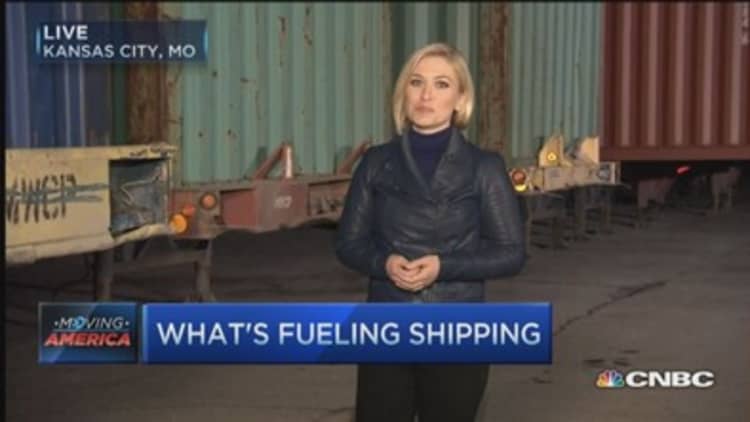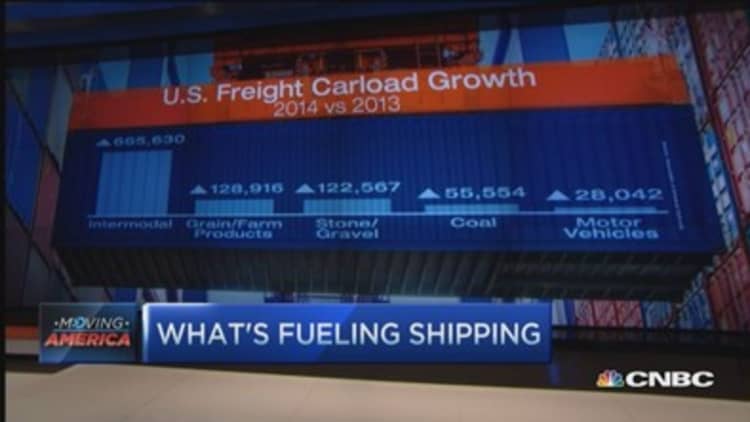
It's a picture perfect day in Kansas City, Missouri, and the echo of train horns can be heard for miles. A locomotive idles on the tracks, ready to lead a long procession of brightly colored containers, stacked two-high and stretching for hundreds of yards.
This is "intermodal" transportation—the movement of containers or trailers from point A to point B using two or more modes of transport, including truck, rail and sometimes cargo ship. And increasingly, it's the lifeblood of American commerce: With nearly 25 million containers and trailers moving via intermodal transport in North America each year, it's the fastest-growing part of the freight business.
The train belongs to Kansas City Southern, the Class I railroad operator headquartered in the nearby downtown. Soon the machine will pull into the CenterPoint-Kansas City Southern Intermodal Center, where containers will be plucked and loaded onto 18-wheeler flatbeds that will cart them to their final Midwestern destinations.
And at this hub and its adjoining Richards-Gebaur Commerce Park, hundreds of thousands of shipping containers filled with everything you'd expect to see in a Wal-Mart or Target will pass through and be transferred between trains and trucks.
"Intermodal is key for us. It's the rising tide that has really put Kansas City on the map," said Chris Gutierrez, president of Kansas City SmartPort, a nonprofit that drums up freight business for the metro area. "Kansas City is one of the largest railroad hubs in the country, and with intermodal growth, we have seen a real value proposition for companies to relocate here."
Read MoreWhat transports are telling us about the US economy
The KC metropolitan area touts multiple intermodal hubs: this one, and another across the river in Edgerton, Kansas, called Logistics Park Kansas City, where Berkshire Hathaway's BNSF railroad has an intermodal facility. BNSF recently announced plans to put more money into the outpost as part of its $6 billion capital investment budget for 2014.
"When you look at the market analysis, the industry analysis, one thing that we do know is that intermodal connectivity is the growth for freight," said Michael Collins, chief executive of the Port Authority of Kansas City.
Outpacing GDP
We've seen a shift from intermodal being more of a substitute service during peak shipping times to an actual mode of transportation—a viable, selected mode.Joni Caseychief executive, Intermodal Association of North America
The vast majority of intermodal traffic is moved in standardized containers that can be easily transferred, stacked atop each other, or hauled singly on the back of a tractor trailer—all without the contents ever having to leave the container. Containers measure 20, 40 or 53 TEUs—a measure of capacity that stands for twenty-foot equivalent units.
The intermodal concept is not new, but it has boomed in popularity in recent years. Last year, the industry grew 5 percent, according to the Intermodal Association of North America (IANA), marking the fourth straight year that it outpaced U.S. gross domestic product—historically, freight transport mirrors GDP. The IANA expects more strong increases this year.
Read MoreHigher shipping rates and the Amazon effect
"We've seen a shift from intermodal being more of a substitute service during peak shipping times to an actual mode of transportation—a viable, selected mode," said Joni Casey, chief executive of IANA. "It's more economical because you can ship two trailer equivalencies on one rail car versus one over the highway."
Unsurprisingly, cost is what's made intermodal transport attractive. For shippers moving large loads over long distances, a combination of truck and rail is cheaper than using trucks exclusively. Not only can more containers be shipped via rail, but trains are more fuel-efficient, making intermodal cheaper for long hauls. A shortage of truckers has also pushed shippers toward the rails.
Railroad renaissance

It's been a boon for the Class I freight railroads, which have taken market share from trucking companies that have ceded the majority of the length of a typical intermodal haul. Last year, a record 13.5 million containers and trailers were transported intermodally in the U.S. with the help of rail, according to the Association of American Railroads, and intermodal is now the single-largest source (22 percent) of the freight rail industry's revenue, offsetting a steep decline in coal shipping.
"It's one of our strategic focus areas, and it has been for a number of years," said Erik Hansen, vice president of intermodal for Kansas City Southern. "We try to leverage growth of this particular segment in order to grow the company overall."
Fredrik Eliasson, executive vice president and chief financial officer of CSX, Kansas City Southern's competitor to the east, expects first-quarter increases in intermodal to help offset declines in coal and slower growth in crude-by-rail, contributing to double-digit earnings growth for 2015.
Read MoreAs oil prices crater, hedge funds dive in
"We have just about gotten back to where we were in 2007 before the recession," said Edward Hamberger, chief executive of the Association of American Railroads, referring to the railroad industry's recent return to overall peak volumes. "The fastest-growing piece of the business is intermodal."
But railroads aren't the only transport companies focusing heavily on the segment. Trucking and marketing companies including J.B. Hunt, Hub Group and Swift Transportation have also brought resources to bear.
Privately held Schneider, one of the largest trucking companies in the U.S., works with railroad operators from BNSF to Kansas City Southern to CSX. The company has been increasing loading lanes at terminals and focusing on new regions like the Southeast, where expansion is fastest. It's also been buying up more containers and truck chassis.
"Intermodal is one of the fastest-growing segments for Schneider," said Bill Matheson, president of Schneider Intermodal. "We believe the intermodal marketplace will grow 8 percent in 2015."
Three trends that could derail the boom
Still, a number of factors could derail that robust projection. Analysts say that they're watching three trends closely:
Oil: On the heels of a dramatic price collapse in crude, diesel prices are about a dollar cheaper per gallon than they were six months ago. Citigroup analyst Chris Wetherbee noted that when fuel prices fall rapidly, as they have recently, trucks get cheaper relative to trains. Avondale Partners' Donald Broughton noted that when diesel prices get cheaper, the cost to move goods solely by trucks becomes more attractive over longer distances.
That hasn't happened yet. Company executives from Kansas City Southern to Schneider told CNBC that rail is still the more fuel-efficient option; what may change, they said, is the pace of growth as more potential customers sit on the sidelines before making the conversion.
Read MoreKeep on truckin'? Inside the shortage of truck drivers
The dollar: The greenback continues to climb to multiyear highs against a basket of other currencies. A stronger dollar makes imports cheaper—good news for international intermodal cargo coming into ports, but bad news for the refilling of containers headed back to port as exports, since a strong dollar also makes exports pricier. Currently, for every full container entering the U.S., a container that's only two-thirds full leaves, according to Broughton.
Congestion: Particularly at the West Coast ports, where recent paralysis crippled the movement of intermodal cargo, congestion is a problem. The ports estimate it will take several months to undo cargo backlogs, and that bottleneck has rippled through the country's freight transport system, including Kansas City.
But as the economy continues to grow, intermodal hubs from the East Coast and Midwest to Houston and Mexico now see California's port pain as an opportunity.
"The growth is being able to connect the rail and truck. We are here to foster that," said Collins of the Kansas City Port Authority, as he walked past rows of containers lined up in a lot awaiting trucks. "What's important is getting it to consumers fast, and that last mile. We understand that dynamic for both the rail and the trucking industry, and we try to connect them."


